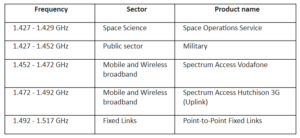Written by: Peter Sanders, Technical Authority at MMX
Most users of the 1.4GHz radio spectrum have always been content with their frequency allocation. It has met their needs reliably at a relatively low cost. However, for those that operate a point-to-point radio system in this frequency range, there is now a requirement to vacate from this allocation.
What’s driving 1.4GHz migration?
The radio spectrum is a finite natural resource that does not respect geographic borders. So, its usage around the world is coordinated between countries where similar frequencies are used for similar purposes. Adjacent countries either with land borders or close sea borders need to ensure that they do not interfere with each other’s radio services, so international and regional coordination is essential.
As technologies and demand change over time, international coordination can be called upon to match the finite spectrum resource with user requirements. It is this latter point which is driving the 1.4GHz migration.
A large slice of this spectrum is allocated to mobile data services, and with the increasing demand on data-hungry 5G services, regulators have agreed to allocate more spectrum in this region for mobile and wireless broadband services.
The UK regulator, Ofcom, plans to have the frequency range 1.492GHz to 1.517GHz cleared of its current users and reallocated to wireless broadband service by the end of 2022.

Table 1 Ofcom 1.4GHz spectrum Allocations as of October 2020.
Table 1 shows the Ofcom allocation of spectrum in the 1.4 GHz region as of October 2020.
Note that 1.452 to 1.492 GHz are already allocated to mobile and wireless broadband services. Spectrum harmonisation will make a larger contiguous block from 1.452 to 1.517 GHz for mobile and wireless broadband services.
From Table 1, the 1.492 to 1.517 GHz spectrum block is currently assigned to point-to-point fixed links. If you are currently licensed to operate a point-to-point link system within this allocation, you will need to review how to provide continuity for your service post-December 2022.
Things to consider before leaving 1.4 GHz
Leaving 1.4GHz is a change that will affect your current operations. To date, it is unlikely to have been factored into strategic reviews of your requirements, capital or operating budgets.
The fact that you are currently operating a 1.4GHz point-to-point link implies you still have a need for its connectivity. Careful consideration is required before scouring for an alternative.
1. Firstly, you should identify whether you need to continue to provide the connectivity you currently have beyond the end of 2022. This may be an easy question to answer as it is likely that your connectivity requirements are increasing rather than decreasing. An area to address is that of any prospective location changes prior to 2023 that will change connectivity requirements. This has the potential to simplify or complicate the situation and will need careful consideration.
2. Once you have acknowledged whether you need an alternative connectivity solution to your 1.4GHz allocation, the next challenge is to look at how to future-proof the alternative and maximise the benefit from your investment. An increase in capacity is almost inevitable. The alternatives on offer will have different capabilities and capacities. Can you predict your requirement five years out? Can your chosen alternative grow with you and your requirements?
3. For utilities and many other businesses, the question of ownership and operation of connectivity solutions is very important from a cyber security perspective. Keeping connectivity within the control of the business is often key in maintaining control of the end-to-end security aspects of a network. Should you provide connectivity yourself and control security, or can you safely outsource its provision?
4. Timeline is a huge consideration with the end of 2022 not that far away. The lead time on delivering your preferred solution could be between 3 and 12 months. Leaving the decision too late may result in you having to go with a non-preferred solution. It is important to act now.
5. Finally , you need to consider where you can get unbiased technical support to guide you through the challenge of leaving 1.4GHz.
How we can help you
Here at MMX we offer a portfolio of services to support clients looking to move out of 1.4GHz. Our consultative approach consists of analysing existing client networks, understanding future requirements then carrying out network modelling at a desktop level. In doing this, hybrid technologies can be implemented as an alternative network typology and with the flexibility to scale for future bandwidth needs. This approach is invaluable to provide a controlled and risk free solution.
We understand that no one technology will prove an end-to-end solution. Following acceptance of the desktop model, we can replicate the desktop modelling within your own lab area. Here we can make adjustments to the design and functionality before moving to the last testing stage. During this stage we would take a section of your network and implement the desktop and lab recommendations in a pilot test to prove our findings. At the heart of this process is our partnership with our clients, who set the requirements for their network.
This approach is key for organisations operating National Critical Infrastructure, where a failsafe approach is required. We understand the technical challenges of designing a multi-technology network which often comprises radio, fibre, copper and PLTE. We also understand the complexities of interoperability testing and the need to provide a solution which meets cyber security stipulations.
Unlike many telecoms companies, we are vendor-agnostic and client-centric and as such, we identify the best solution for you rather than try to fit vendor tied supplier equipment or service to your requirements.
As mentioned, time is limited if you are to meet the Ofcom deadlines with the best solution for your needs. It’s important to keep in mind that delaying may mean compromising on the service you get.
Contact us now to help you get started on your 1.4GHz migration. Our expert designers and engineers will be more than happy to discuss the challenges you may face, and how best to meet your requirements.

